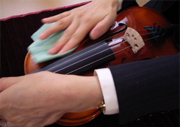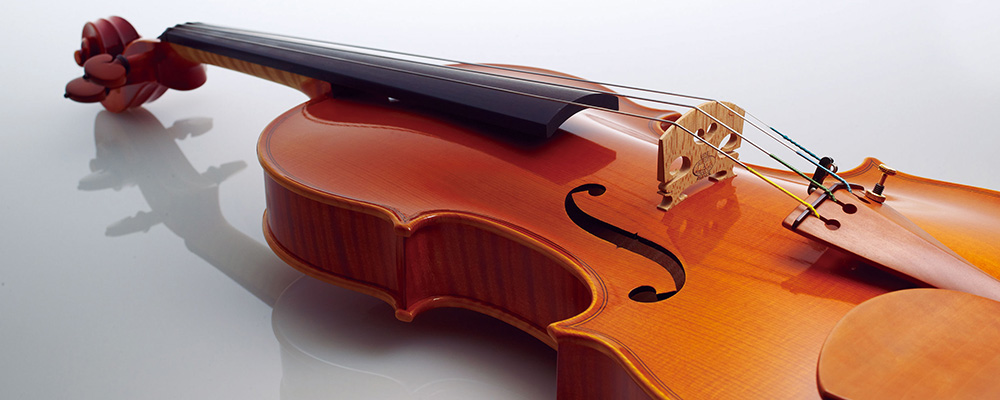Care and Maintenance of a Violin
Daily care and maintenance
The golden rule: wipe after playing!
The varnish on a violin is very delicate. The tone of violins, guitars, and other acoustic instruments is influenced to a great degree by the varnish, making it an important element of the instrument. Thus, to keep the finish in good condition, always wipe the instrument after playing. This is an iron-clad rule. The instrument should be wiped with a cloth specially designed for this purpose, or a chamois.
Where possible, one cloth should be used only for the strings and the fingerboard, which should be wiped well. If the strings are thick with rosin, their tone will suffer and may produce noise. The fingerboard easily becomes dirty with sweat from the fingers. Normally, a dry cloth is used to wipe down the instrument, but if there is a significant build-up of rosin or other matter on the top plate, please consult a specialist.

After playing, always wipe.
Once you are done playing and have wiped the instrument, always put it in the case. The violin is so delicate that it may start to creak and pop if exposed to the wind of an air conditioner. The optimum humidity for a violin is 50%. To keep the violin's environmental conditions as close as possible to this ideal, make a habit of putting the violin in its case immediately.
Storing your violin
Violins are sensitive to changes in temperature and humidity. If they are kept stored in high humidity and temperature the top plate and bottom plate will swell, changing the thickness of the body and causing the sound post to collapse. Conversely, if the instrument is kept in a dry environment for long, the fingerboard could detach from the body. Violins should therefore be stored in environments where the humidity and temperature are kept as stable as possible. If just being a room gives you a cold or makes you feel uncomfortable, it's probably a poor choice as a place to store your violin.
Another point to consider is that the body of the violin has many curves, so it's not safe to just place somewhere without any thought. Note also that the varnish on the violin should not be exposed to direct sunlight. You should therefore store your violin in its case, in a safe location.
Be cautious with cleaners that contain polish
The regular care of stringed instruments consists of wiping the instrument with a dry cloth specially designed for stringed instruments each time after playing. Normally, this is all that is needed, but when used over a long period of time, the violin acquires an unavoidable build-up of rosin dust around the bridge, and of grease and fingerprints on the fingerboard and other places where the skin comes into direct contact with the instrument. Use a cleaner to clean the instrument when this build-up becomes noticeable. This not only removes the build-up but also restores luster to the varnish.
There are many types of cleaner on the market, and they differ primarily in the type and volume of the polish that they contain. Simply put, those without polish do not have the strength to remove a great deal of dirt, but they are kind to the instrument. In contrast, those with polish remove build-up, but may also harm the instrument.
All cleaners are used basically in the same way. Using two cloths specially designed for stringed instruments, put a small amount of polish on one to remove the dirt, and use the other to wipe down the instrument after the dirt is removed. If the same cloth is used for both purposes, the instrument will become dirty again, so be sure to use two cloths. When using a cleaner that contains polish, shake the bottle well before using, and be careful not to wipe hard. However, cleaners that do contain polish will inevitably remove a very small amount of the varnish and so should not be used on old instruments. If there is some resistant dirt that does not come off with normal polishing, consult a specialist.
Musical Instrument Guide : Violin Contents
Origins
Structure
How to Play
How the Instrument is Made
Choosing an Instrument
Care and Maintenance
Trivia
- The f-hole used to be a C-hole or S-hole
- Why the f-hole?
- Violinists must bow to the horse
- Steel strings or gut strings? That is the question
- Is the chinrest the unsung hero of the violin?
- Most violin varnishes are also medicines
- Violin masterpieces: Solos I
- Violin masterpieces: Solos II
- Violin masterpieces: Solos III
- Violin masterpieces: Concertos I
- Violin masterpieces: Concertos II
- Viola masterpieces: Chamber music
- Viola masterpieces: Concertos
- Cello masterpieces: Concertos I
- Cello masterpieces: Concertos II
- Cello masterpieces: Solos
- Contrabass masterpieces: Concertos
- Contrabass masterpieces: Chamber music
- Orchestral masterpieces featuring the contrabass
- What do you call the part on the bow that you hold?

